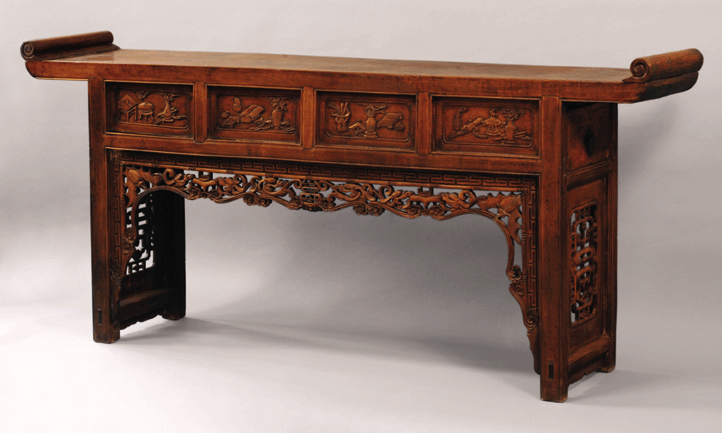
Mid 1800’s, Northern Elm, Shanxi. Quality construction with beautiful carved antiquity designs; drawer slides out at each end; excellent condition.
34½” h. 76¾” w. 15” d.
This altar table shows excellent craftsmanship. It is constructed in the traditional mortise-and tenon method. The top is constructed from one thick solid plank and ends with scrolled inverted flanges. Below it, four framed recessed panels edged with beading show deep relief carvings depicting the Four Accomplishments of the Scholar: Pictorial scrolls, books, chess board and musical instrument (zitar). The apron consists of two beautifully carved parts: the top part is a recessed waist of an interlocking key-fret or wandering-clouds design (signifies a wish for wealth from above) which continues down the side of the inner legs to almost floor level; separating this key-fret design panel is a knotted bamboo style stretcher below which hangs a magnificent openwork carving of the running dragons (favorite design during the Emperor Qianlong period) with a canopy (royal grace) in the middle and a bat (symbol of happiness and prosperity) at each corner with its mouth and wingtips grasping the wide arc of the end of a trailing rosette trimming below the row of running dragons.
This long table has no drawer opening out from the front but has one sliding out at each end. Below the drawer and between the legs is a panel with openwork carving of a symbol of “long life”, flanked on each side by motif of a bat with each wingtip grasping an interlocking circle meaning “everlasting”.
This table, with outstanding construction and superb carvings of auspicious motifs, shows it was made for a member of the elite scholar/official class. It is sourced from Shanxi and was collected in the1990s when China opened to the outside world. It survived in excellent condition due to its location in northern China, guarded by the Great Wall nearby from wars and their ravages, and the relatively dry climate in that region that helps in preserving wood furniture.